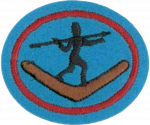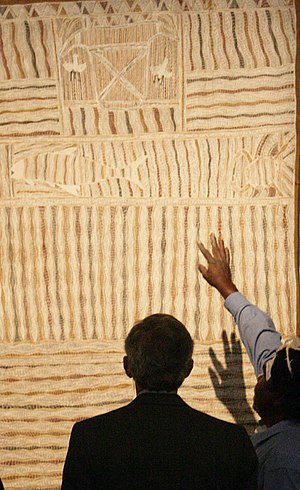Difference between revisions of "AY Honors/Aboriginal Lore/Answer Key/es"
(Created page with "{{clear}}") |
(Created page with "==9. ¿Qué juegos juegan los niños? ¿Cómo son los hombres jóvenes entrenados? ¿Cómo son iniciados?¿Cuál es el terreno de Bora? ¿Qué es una bramadera?��==") |
||
| Line 118: | Line 118: | ||
{{clear}} | {{clear}} | ||
| − | + | {{clear}} | |
| − | |||
| − | ==9. | + | ==9. ¿Qué juegos juegan los niños? ¿Cómo son los hombres jóvenes entrenados? ¿Cómo son iniciados?¿Cuál es el terreno de Bora? ¿Qué es una bramadera?��== |
| − | |||
| − | |||
{{clear}} | {{clear}} | ||
Revision as of 21:25, 1 December 2014
| Folclore de Aborígenes Australianos | ||
|---|---|---|
| División del Pacífico Sur
|
Destreza: 1 Año de introducción: Desconocido |
|
Requisitos
1. ¿Quiénes son los aborígenes y de dónde han venido? ¿Cuántas tribus había allí cuando comenzó la colonización europea?
2. Discutir el sistema tribal. ¿Qué son los tótems?
3. Discutir el alimento de los aborígenes:
a. Clases
b. ¿Cómo lo obtienen?
c. ¿Cómo lo preparan?
4. Discutir acerca de sus viviendas. ¿De qué son hechas? ¿Por qué no son permanentes?�� ¿Dónde duermen los jóvenes y niños?
5. ¿Cómo se comunican con otras tribus que no puede entender su idioma? ¿Cómo envían señales dentro de la tribu? ¿Cuál es el propósito de la Tjuringa (o Churinga)?
6. ¿Cuáles son algunos de los artículos de comercio e intercambio? ¿Qué utensilios domésticos utilizan ellos?
7. Describir algunas de las armas utilizadas en la caza y la guerra.�
8. ¿Qué es un corroboree? Explicar su propósito. ¿Qué son palos de aplaudir y el diyiridú?
9. ¿Qué juegos juegan los niños? ¿Cómo son los hombres jóvenes entrenados? ¿Cómo son iniciados?¿Cuál es el terreno de Bora? ¿Qué es una bramadera?��
10. Discuss the two main types of Aboriginal art.
There are many "types" of Aboriginal art, but the two most famous types appear to be bark painting and rock art.
Bark Painting
Bark painting is an Australian Aboriginal art-form which is done on the interior strip of a tree bark. Traditionally, bark paintings were produced for instructional and ceremonial purposes and were transient objects. Today, they are keenly sought after by collectors and public arts institutions.
11. Briefly relate the history of the Aborigines since the white man arrived in Australia, mentioning the government policies through the years and the work of missions.
1788-1900
In 1770, Lieutenant James Cook claimed the east coast of Australia in the name of Great Britain and named it New South Wales. British colonisation of Australia began in Sydney in 1788. The most immediate consequence of British settlement – within weeks of the first colonists' arrival – was a wave of European epidemic diseases such as chickenpox, smallpox, influenza and measles, which spread in advance of the frontier of settlement. The worst-hit communities were the ones with the greatest population densities, where disease could spread more readily. In the arid centre of the continent, where small communities were spread over a vast area, the population decline was less marked.
Referencias
- Categoría: Tiene imagen de insignia
- Adventist Youth Honors Answer Book/Honors/es
- Adventist Youth Honors Answer Book/es
- Adventist Youth Honors Answer Book/Skill Level 1/es
- Categoría: Libro de respuestas de especialidades JA/Especialidades introducidas en Desconocido
- Adventist Youth Honors Answer Book/South Pacific Division/es
- Adventist Youth Honors Answer Book/Unknown/es
- Adventist Youth Honors Answer Book/Unknown/Primary/es
- Adventist Youth Honors Answer Book/Stage 100/es
- Adventist Youth Honors Answer Book/Completed Honors


